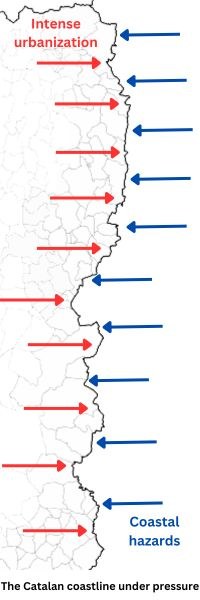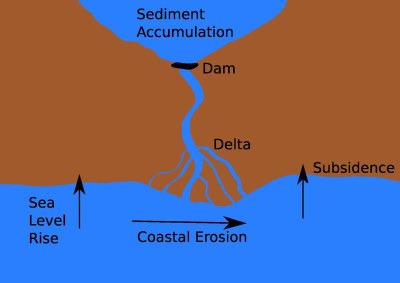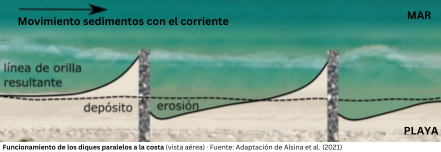CoastSpace project: developing adaptation strategies for the Catalan coast to the impacts of climate change
Jun 12, 2024
The Catalan coast is increasingly vulnerable to the risks of climate change due to its high urban density and the presence of infrastructures exposed to coastal erosion. Nature-Based Solutions (NBS) and Managed Retreat offer sustainable alternatives to address these long-term risks, but face social resistance. The CoastSpace project, funded by the EU and led by the UPC and the UdG, seeks to create a planning model to implement a coastal adaptation strategy to climate change. The analysis of social perception and the implementation of participatory governance can be key to the success of these measures.
Context: a Catalan coast very vulnerable to climate change

The coast of Catalonia stretches along 650 km in 70 municipalities next to the Mediterranean Sea. This coast has a high urban density: 59% of the total is urbanized in its first 100 meters along the sea. Thus, 45% of the Catalan population resides in the 70 municipalities that make up the Catalan coast, whose population density ranges between 10,000 and 17,000 inhabitants/km².
It has been observed that the combination of the excessive urbanization of the coast in certain areas, the coastal artificial barriers - such as the dikes, breakwaters, breakwaters or piers of the new seaports - and the reservoirs in the rivers - which block the arrival of tons of sediment to the sea – contribute to the disappearance of beaches. This progressive coastal erosion reduces the protective natural barrier such as the beaches themselves, the dunes and the wetlands.

In recent decades, it has been shown that the increase in coastal erosion is one of the factors that accentuates the collateral damage associated with storms, floods and sea level rise on the Catalan coast (for example, thereafter in Badalona, and here in Calonge and Sant Antoni, here in s'Antiga de Begur). It is for this reason that the coastal communities find themselves, more and more, in a vulnerable situation that must be faced.
A long-term solution: de-artificialization of coasts and restoration of coastal/natural protective ecosystems
In the long term, we have observed different negative impacts associated with hard infrastructures (dikes, breakwaters), such as the degradation of the natural functioning of coastal ecosystems, thereby accentuating the phenomenon of acute erosion upstream or downstream. Therefore, these costly solutions are being questioned as a measure to adapt to future increasing coastal risks in a changing climate.

In this sense, the so-called Nature-Based Solutions (NBS) appear as a promising approach to address the climate emergency. These solutions propose strategies to reduce flood risks, combat coastal erosion and deal with the challenges posed by sea level rise. These are more sustainable, long-term profitable and environmentally friendly alternatives to conventional, harder coastal engineering measures such as breakwaters and dykes. NBS strategies include restoration of coastal wetlands, salt marshes, dune systems and beach vegetation.
However, much of the public and policymakers think that NBSs are not as effective as traditional gray infrastructure in mitigating the impact of natural hazards, even though they have been shown in different coastal contexts to provide significant benefits for the human and natural well-being that compensate in the long run for its cost.
In order to carry out the implementation of this type of measures, sufficient space is needed for the correct development of the natural habitats to be restored. It has been seen, however, that in many urbanized sections of the coast, this space is insufficient. This prevents the development of these ecosystems – such as dunes – that are "caged" between a rising sea and a static artificial structure - referred to as the "coastal squeeze" effect.

Therefore, the incorporation of SBNs into coastal adaptation strategies requires that there is sufficient development space, which can be provided through strategic measures to relocate infrastructure (e.g. promenades or parking) present in coastal stretches of risk.
However, this preventive action is quite controversial and faces significant resistance from relevant stakeholders, creating a social barrier that hinders the development of strategies based on infrastructure removal and ecosystem restoration coastal A successful coastal adaptation strategy that is well received by society requires a good understanding of the social perception that the population has of these measures and their benefits.
The CoastSpace project: a regional planning model for SBNs as a coastal adaptation strategy
Within this perspective, the European-funded project CoastSpace, "Searching for accommodation space to adapt to present and future risks in coastal areas", aims to address issues related to adaptation to climate change, the protection and restoration of biodiversity and the coastal ecosystem, supporting the development and implementation of environmental policies. Within the framework of the Spanish government, it aims to contribute to the objectives of ecological transition at the national level.
This project is developed by the research teams of the Social Studies Laboratory of Civil Engineering (LESEC) - whose members are part of the University Institute for Research in Science and Technologies of Sustainability (ISST) - and the Laboratory of Maritime Engineering (LIM) from the Polytechnic University of Catalonia (UPC) as well as the University of Girona (UdG). The main objective of the CoastSpace project is to develop a model at a regional scale (using the Catalan coast as representative of the Spanish Mediterranean coastal zone) for planning the relocation of infrastructures and making use of the SBNs –such as the dunes – as adaptation strategies.
Within the framework of this project, ISST researchers are working to analyze the social perception of these measures in order to propose recommendations in terms of participatory governance, focusing on communication and exchange with local stakeholders. This analysis is based on a survey of social perception at a regional scale and several in-depth qualitative study workshops in certain municipalities most exposed to coastal risks.

The future of Mediterranean beaches is uncertain due to the impacts of climate change, but there is still time to act and adapt, for the common good.
That's why we're asking you to help us today by taking a few minutes to answer the following questionnaire and share it with people who might be interested in contributing too! The future of the coast depends on each and every one of us. Thank you so much!
Do you have any questions about the project? Contact us: institut.sostenibilitat@upc.edu

Share: